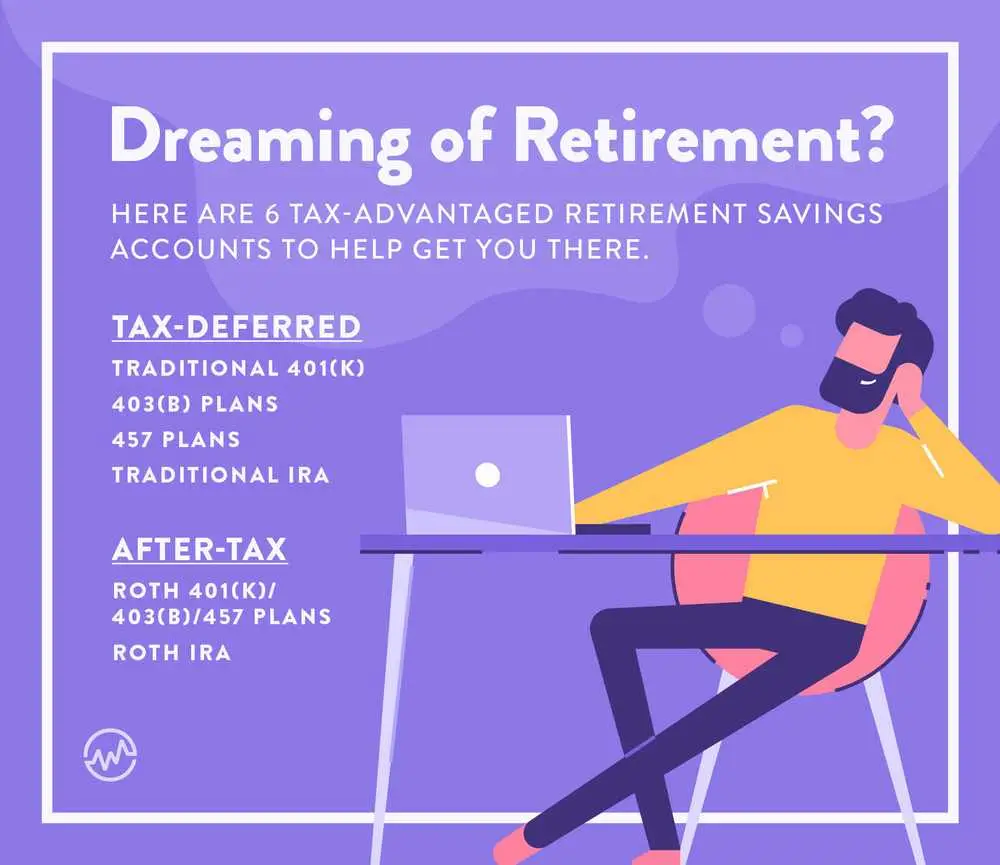No matter how you feel about taxes, you have to pay them. But you want to owe as little as possible keeping more money in your pocket, right? Using tax-advantaged savings accounts for your investments can help you do just that.
Taxable savings or investment accounts—like traditional savings accounts, money markets, CD’s, brokerage accounts—require you to pay taxes in the year you receive earnings.
Tax-advantaged accounts are different.
They give you some say when you pay taxes on contributions you make to the account, and on any gains you receive.
You should be strategizing how you can pay less taxes legally as a part of your overall personal finance plan. Using tax-advantaged accounts is a way to help you do just that.
[Wanna pay less taxes? DOWNLOAD a list of 51 little-known tax deductions to make sure you maximize your deductions, and minimize your taxes!]
What is a Tax-Advantaged Account?
A tax-advantaged account is a kind of savings plan or financial account, providing you with a tax benefit such as tax-deferral or tax exemption.
Tax-advantaged accounts are popular for retirement savings, education expense savings, and savings for healthcare expenses. Examples of investments within a tax-advantaged account include stocks, actively managed funds, high-yield bonds, REITs, and annuities.
Tax-advantaged accounts come in two forms:
- Pre-tax (or tax-deferred) investment accounts. tax-deferred accounts defer your tax payments on contributed amounts until a later date. This is usually many years into the future; delaying any taxes due on investment gains until funds are eventually withdrawn.
- After-tax investment accounts. These tax-advantaged accounts are funded with contributions you’ve already paid taxes on. The advantage comes from not having to pay taxes on any of your investment earnings.
Each type of tax-advantaged account has different retirement savings options, like employer-sponsored defined contribution plans or individual retirement arrangements.
All, of course, have rules to follow such as contribution limits, timing of withdrawals, participation eligibility, etc.
Additionally, there are also tax-advantaged investment accounts available for education, health care savings, and childcare expenses.
Let’s take a look at the various tax-advantaged savings accounts in greater detail to see how you can maximize your savings while minimizing your taxes.
Tax-Advantaged Retirement Savings Accounts

Tax-Deferred Plans
The traditional 401(k), 403(b), or 457(b), are the most common types of employer-sponsored savings plans. These are defined contribution plans mostly funded by the employee, with some lucky people also receiving matching employer contributions.
Traditional 401(k) Plan
Larger, for-profit businesses frequently offer a traditional 401(k) savings plan to their employees.
Eligible employees choose the amount of their tax-deferred contribution up to defined limits and how they want to invest it. Investment options offered by employers will vary.
As an additional employee benefit, some employers also contribute to the employees 401(k) plan.
For 2019, annual employee contribution limits are $19,000. Employees 50 and up may contribute an additional $6,000, known as “catch-up” contributions.
Wages you contribute to a 401(k) plan are always yours, even if you leave the employer. Employer contributions could be subject to a vesting schedule though.
Upon leaving an employer, you can keep the money in their plan, move it into a new employer’s traditional 401(k) plan, or roll it over into a Traditional IRA without paying any taxes or penalties.
Should you withdraw funds before age 59.5, you will pay taxes and a 10% penalty in the year of withdrawal, although some exclusions apply.
After age 59.5, any withdrawals you make are taxable at ordinary income rates for that year.
Tapping the retirement fund is up to you until you turn 70.5. At that point, the government requires you to take distributions.
Yes, they want their tax money eventually and won’t allow you to keep delaying them forever.
These required minimum distributions (or RMD’s) prevent you from further deferring tax payments.
403(b) Plans
A 403(b) is essentially a 401(k) for employees of non-profit, tax-exempt businesses—think schools, universities, churches and religious organizations, or hospitals.
Tax rules and contribution limits are the same as 401(k)s. Accounts are funded with tax-deferred contributions, and accumulated earnings—a company’s net profits which aren’t distributed as shareholder dividends and are instead reinvested back into the company. Both of these are not taxed until withdrawal.
457 Plans
Like 403(b) plans, 457 plans are almost identical to 401(k) plans except they are for state and local government employees. Again, they are very similar to a 401(k) regarding taxes and contribution limits, but they do offer some additional advantages.
- Some employers offering a 403(b) may allow for double contributions when you’re within three years of your plan’s normal retirement age.
- If your employer offers both a 401(k) or a 403(b) and a 457 plan, you can fund both. This allows you to defer taxes on your contributed wages up to $38,000 ($50,000 if you’re 50 or older); $19,000/$25,000 per plan.
- Early withdrawals from a 457 plan are subject to taxes but not the 10% penalty.
Traditional IRA
A Traditional Individual Retirement Arrangement—commonly called a Traditional Individual Retirement Account (IRA)—is another tax-deferred savings account.
Contributions are deductible on your tax return in years when you are younger than 70.5, and you (or your spouse) earned taxable income.
However, if you’re eligible for an employer-sponsored retirement plan and your modified adjusted gross income (MAGI) exceeds the income threshold, you may not be allowed the IRA contribution deduction on your tax return.
You can still contribute to an IRA (known as a non-deductible IRA) and receive the tax-advantaged benefit of deferring taxes on your investment growth.
In 2019, you can contribute up to $6,000 to an IRA ($7,000 if 50 or older). Contribution limits don’t apply to any 401(k) to IRA rollovers, however.
This means if you have $20,000 sitting in an old employer’s 401(k) plan, you can roll over the entire amount into a traditional IRA plan.
Like employer-sponsored tax-advantaged accounts, if you’re not yet age 59.5 and withdraw funds from a traditional IRA, you’ll pay a 10% early withdrawal penalty, unless meeting an exemption requirement.
With any of the retirement accounts above, you’re kicking tax payments on the income you contribute to them, from the year you earn it, to the year you withdraw it. The hope is that when you make any future withdrawals, you are in a lower tax bracket than when you make the contribution
After-Tax Retirement Savings Accounts
Savings accounts for retirement, funded with post-tax income are known as Roth accounts. Saving in a Roth account makes sense if you expect your tax rate to be higher in retirement than your current tax rate today.
Roth 401(k)/403(b)/457 Plans
Your employer may also offer a Roth deferral option in your 401(k), 403(b), or 457 plan. Contributions made in this option are after tax.
This means you won’t receive a tax benefit in the year of contribution, but investment earnings accumulate on a tax-deferred basis.
Distributions will be tax-free if they have been in the plan for five years, and if you are age 59.5 or older at time of withdrawal.
Otherwise, the investment earnings portion of early distributions will be subject to regular income tax and the 10% early withdrawal penalty.
You can contribute the same amount to a Roth 401(k) plan as you can to a traditional 401(k) — but any matching employer contributions will be placed in the traditional option.
You may split contributions between traditional and Roth IRAs, but total contributions between accounts cannot exceed the annual limits.
Additionally, funds in a Roth 401(k) plan when you reach 70.5 years of age, are subject to RMDs. You can avoid this by rolling the funds over into a Roth IRA plan at retirement or when otherwise leaving your employer.
Roth IRA
With a Roth IRA, you won’t deduct your contributions on your tax returns. But you can take qualified distributions on your contributions and any earnings tax-free.
You can contribute to a Roth IRA at any age if you (or your spouse if filing jointly) have taxable earnings and your MAGI is below certain income limits.
Annual contribution limits are the same as a traditional IRA, currently up to $6,000 ($7,000 if you’re age 50 or older).
Contributions may be split between traditional and Roth IRAs, but total contributions between accounts cannot exceed the annual limits.
Roth IRAs are not subject to RMDs and can stay in your account as long as you are alive.
Plus, you can continue contributing to a Roth IRA beyond the age of 70.5 if you so desire.
Roth Solo 401k
A Roth Solo or Individual 401(k) has the same benefits of an individual 401(k), with Roth IRA tax benefits.
The same contribution limits as the Solo 401(k) apply, but contributions will be made after-tax leaving future withdrawals tax-free. Contribute up to $19,000 in 2019, or $25,000 if you’re at least 50 years of age.
Which Should You Choose, tax-deferred or After-tax?
You might be wondering which tax-advantaged accounts you should use—it’s a common question.
The answer depends on your income and financial goals. But the following recommendations will work for most people:
- If your employer offers a match on any contributions to your 401(k) or similar plan, contribute the amount needed to receive the entire employer match. Free money is free money! Get it when you can.
- Fund a Roth IRA up to your contribution limits.
- With any remaining funds, max out your employer-sponsored plan.
When you have additional money available to contribute, use the tax-advantaged accounts described below when applicable.
Other Tax-Advantaged Savings Accounts

If you’d like to save for your child’s education or you participate in a High Deductible Health Insurance Plan (HDHP), you’ll want to look at the following tax-advantaged accounts.
College/Education Savings Plans
529 Plans
The most popular savings account for education is the 529 plan, also known as a Qualified Tuition Program (QTP). After-tax contributions grow tax-deferred in a 529, and when paying for qualified education expenses, withdrawals from the plan are tax-free.
These accounts are state-run, but you don’t necessarily need to participate in your state’s 529—you can shop around for the best plan.
529 account owners can withdraw funds from the plan at any time for any reason—but the earnings portion of non-qualified withdrawals will face regular income taxes plus a 10% penalty tax.
Transferring the account to another beneficiary is typically allowed should the child choose not to attend college.
These programs do not have annual contribution limits but could have lifetime contribution limits: $235,000 to $500,000 depending on the plan. Federal law says 529 account balances are not to exceed expected qualified higher education expenses of the beneficiary.
Coverdell Education Savings Account (ESA)
Like a 529, an ESA allows for tax-deferred growth on after-tax contributions, with tax-free withdrawals for qualified education expenses. Any funds not used before your child turns 30 could face taxes and penalties.
You may contribute $2,000 per child per year, although contributions phase out for anyone with a MAGI more than $95,000 per year.
Note: 529 and Coverdell’s are considered your asset, not your child’s for financial aid purposes.
Health Savings Accounts (HSAs)
Health Savings Accounts or HSAs are tax-advantaged savings accounts used to pay healthcare expenses. Contributed funds grow tax-free, and withdrawals are tax-free when used for qualifying medical expenses.
Eligibility is restricted to those with a High Deductible Health Insurance Plan (HDHP), who are not enrolled in Medicare.
They cannot be claimed as a dependent on someone else’s tax return, and they are not covered under other disqualifying health coverage such as a Health FSA described below.
Many employers now offer HSAs, but they are also available through financial institutions.
Contributions to an HSA are made tax-deferred when funded through your employer. While contributions are technically made with post-tax funds when not done through your employer, you’ll adjust for this when filing your tax return reducing your taxable income for the year.
For 2019, contribution limits for those under eligible family medical plans are $7000/$3500 single. (Those 55 years or older can contribute an additional $1000 to the above account limits.) Your employer may also make contributions to your plan.
You must use funds in your HSA on qualified medical expenses, or penalties will apply.
Qualifying costs are those you typically incur to treat or prevent a physical or mental defect or illness, including any vision and dental care.
Fortunately, money in an HSA is not subject to any use or lose it rules.
Instead, unused funds accumulate interest. Some HSA plans even offer you the opportunity to invest these funds similar to a 401(k) account, providing you with yet another way to save additional tax-free money after maxing retirement account contributions.
An HSA can be cashed out for non-medical purposes when you reach age 65, but there are no RMDs at age 70.5 if you chose to keep the HSA funded.
Any funds withdrawn for non-qualified medical expenses before you reach age 65 are not only subject to income tax but a 20% penalty as well.
More tax-deferred Savings Accounts

Flexible Spending Accounts (FSA) also known as Flexible Spending Arrangements are additional employer-sponsored accounts allowing you to stash tax-deferred funds to pay for eligible expenses.
While contribution limits are not significant on these tax-advantaged accounts, and they are subject to the “use it or lose it” rule, you will save taxes on the income you contribute.
Usually, FSA decisions can only be made at the start of your employment and during your employer’s open enrollment period.
However, certain “qualifying events,” such as a new dependent, may allow for making changes to your FSA.
Check with your human resource department to see if your employer offers any of these as a benefit.
Health Flexible Spending Account (FSA)
If you’re not eligible for an HSA, you might consider a Health FSA. Depending on the limits of your employer’s plan, you could save up to $2,700 of your wages in an FSA (2019).
If married and your spouse is also eligible for a Health FSA, they can fund theirs too.
Contributions made to your FSA are tax-deferred through payroll deductions. Your employer might also provide money as a further benefit.
Health FSA funds may be used on a variety of healthcare expenses, such as office-visit co-pays, deductibles, medical equipment, dental and vision services, and prescriptions, for you and your eligible dependents.
Limited Purpose FSA
As mentioned in the Health Savings Account section earlier, you cannot contribute to an HSA if you are covered “under other disqualifying health coverage.” Health FSAs count as other coverage.
But a Limited Purpose FSA is a designed “HSA-compatible FSA” allowing for use on vision and dental expenses only.
Except for the vision and dental expenses only requirement, a Limited Purpose FSA is similar to the Health FSA in all other ways.
Dependent Care FSA
Childcare costs, such as daycare, preschool, before/after school care, summer day camps, and nanny expenses are usually eligible expenses. Adult care typically qualifies too when the care is for an older child, spouse, or relative living in your home, who is incapable of self-care.
Dependent Care FSA, or Dependent Care Assistance Plans, have a $5,000 annual contribution limit.
Because of the “use it or lose it” rule on all types of FSAs, carefully estimate your out-of-pocket expenses each plan year before committing to your tax-deferred contributions.
While you typically must use funds in your health savings plan during the plan year, your employer may provide either (but not both) a 2.5-month grace period or allow you to carry-over $500 to the next year.
Max Out Tax-Advantaged Accounts to Pay Fewer Taxes
Taxes will not and should not be your only consideration when determining where and when to save and invest your money.
But it’s clear using tax-advantaged accounts is beneficial.
By maxing them out whenever and wherever possible, you can keep more money in your pocket.
How to Decide What’s Best For You
To help you decide where to put your money, first determine your eligibility for and access to the various tax-advantaged accounts above.
Consider the following questions:
- Does your employer offer both a Traditional and a Roth 401(k)/403(b)/457 Plan?
- If married, what type of 401(k)/403(b)/457 Plan does your spouse’s employer offer?
- Does your (or your spouse’s) employer contribute to your retirement savings plan? If yes, is it a matching contribution requiring you to contribute a specific percentage?
- Will your annual income disqualify you from investing in a Roth IRA? If yes, could you defer some income into a Traditional 401(k) plan to reduce it enough for Roth IRA eligibility?
- Do you hold a high deductible health insurance plan allowing you to use a health savings account (HSA)?
- Is a Health or Dependent Care FSA available to you through your or your spouse’s employer?
- Is it essential for you to provide for some or all of your children’s college education?
Then, you’ll want to order the funding of them based on:
- Your income
- Current and expected future tax brackets
- Savings goals/priorities
- Time horizons for each target
- Each tax-advantaged accounts:
1) Contribution limits
2) Investment options
3) Ease of use
4) Potential tax-savings
Your decision to invest pre or post-tax will come down to individual values and when you feel it’s best to pay taxes on your income.
While it’s great to receive tax savings today, the benefit of receiving tax-free or tax-exempt retirement income in the future is something you can’t overlook.
Generally, low-income earners will want to focus on putting their money in post-tax accounts (Roths), while high-income earners will want to defer taxes by contributing pre-tax. A combination of pre-tax and after-tax investing will create a tax diversification strategy beneficial for most.
With uncertainty about future tax brackets and where you’ll find yourself down the road, diversifying your investments between various tax-advantaged accounts is a strategy worth considering.
Maximizing contributions to both types of tax-advantaged accounts now provides you with flexibility later in terms of managing where you’ll draw your retirement income from and the resulting taxes if any you’ll pay on those withdrawals.












